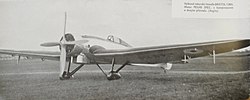Bristol High Altitude Monoplane
| Bristol High Altitude Monoplane | |
|---|---|
 Bristol 138A |
|
| Type: | Experimental airplane |
| Design country: | |
| Manufacturer: | |
| First flight: |
May 11, 1936 |
| Number of pieces: |
1 + 1 |
The Bristol High Altitude Monoplane (factory designation Type 138 ) was a research aircraft produced by the British manufacturer Bristol Airplane Company . It was specially developed and built to surpass the existing absolute altitude record. The Italian Renato Donati had increased it in 1934 with a Caproni double-decker - also powered by a Pegasus - to 14,435 m. The altitude record was previously held by Cyril Uwins, who had reached 13,420 m (44,000 feet) on a modified Vickers Vespa .
history
After the flight of two Westland biplanes over Mount Everest , the Air Ministry showed interest in supporting record flights. In November 1933, for example, Bristol submitted the proposal of a large single - seater low - wing aircraft with the Type 138 , which was not implemented due to the high estimated costs. Development work was only resumed after Donati's record flight. Bristol received in June 1934 the request to prepare an offer according to the tendering requirements ( Air Ministry Specification ) 2/34. In September 1934, construction work on the Type 138A - which retained the dimensions and design of the Type 138 - was completed. A modified Bristol Pegasus with a two-stage mechanical supercharger that drove a rigid four-bladed propeller was used as the drive.
The first flight of type 138A (RAF serial number K4897) with Cyril Unwins at the controls took place on May 11, 1936 in Filton . A standard Bristol Pegasus with a three-blade propeller was installed as the engine. In August 1936, the aircraft then received the elevator engine and the four-blade propeller. With this, Squadron Leader FRD Swain was able to bring the world record back to England on September 28th with 15,230 m. In May 1937, however, it was again outbid by an Italian Caproni Ca.161 with 15,665 m. The Bristol 138A has now been modified again so that Fl. Lt. MJ Adam was able to set the new record with her on June 3, 1937 at 16,440 m.
The two-seater Bristol 138B, ordered for comparison purposes in 1935 and equipped with a special Rolls-Royce Kestrel , was delivered to Farnborough in 1937, but the engine was no longer installed.
construction
The cell of the type 138 was designed as a half-shell construction made of wood. The cockpit was covered with a plastic hood. A second place for an observer could be set up in front of the pilot. The machine had a large wing span, also made of wood, and a fixed undercarriage. There was no pressurized cabin . The pilot therefore had to wear a pressure suit during the flight .
variants
- Type 138 - not built
- Type 138A - one built
- Type 138B - one built to be powered by a Rolls-Royce Merlin , but never flew
Technical specifications
| Parameter | Data |
|---|---|
| crew | 1 |
| length | 13.41 m |
| span | 20.12 m |
| height | 3.12 m |
| Wing area | 52.77 m² |
| Empty mass | 1996 kg |
| Max. Takeoff mass | 2414 kg |
| Top speed | 285 km / h at 13715 m |
| Service ceiling | 16,500 m |
| Rate of climb | 436 m / min at 12190 m |
| Range | 2.25 h |
| Engines | 1 × Bristol Pegasus PE.6S with 373 kW |
See also
literature
- CH Barnes: Bristol Aircraft since 1910. Putnam, 4th edition 1988, ISBN 0-85177-823-2
- Owen Thetford: Aircraft of the Royal Air Force 1918-57. 1st edition, Putnam, London 1957.
- Jim Winchester: Bristol Type 138. X-Planes and Prototypes. Amber Books Ltd., London 2005, ISBN 1-904687-40-7 .
Web links
Individual evidence
- ^ Bristol Type 138. Flight, October 1, 1936.
